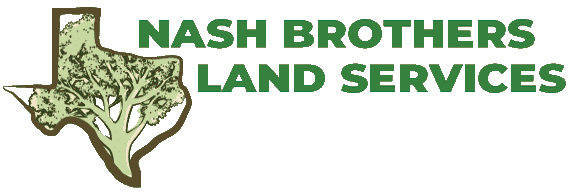
We provide the best land Services in Central Texas
TXT or CALL for a free estimate
Founded by Tyler and Brian Nash, Nash Brothers Land Services is a family based land clearing and tree service located in the heart of the Heart of the Texas Hill Country. Each member of our family over three generations brings something unique to the table, from tree trimming and felling techniques to equipment maintenance and operation. Our objective is to provide a full range of land clearing, brush management, and tree service solutions for properties of all sizes. We tailor a solution for each project to meet our customer’s goals, vision, and budget. We understand the native flora and fauna and can execute low-impact selective clearing techniques that result in fast ground recovery times and foster a healthy variety of native trees, plants, and grasses. We are here to help you enhance your property value and create usable space. Contact us now and let us know how we may be of service. We will contact you within 24 hours.
Licensed Professionals
Online Service Booking
Eco Friendly Services

We Are A Locally Operated
Family Owned Business


TREE TRIMMING & REMOVAL


Roadwork

COMMERCIAL SITE PREP
Land clearing, mulching, and haul off for any commercial project.
RESIDENTIAL LOT CLEARING
We offer highly detailed lot clearing, removal of brush, tree and low-lying limbs, and branch trimming services.

Nash Brothers Land Services is proud to partner with Texas Urban Sawmill to provide the most sustainable land services in Texas that prioritize environmental preservation and responsible land management practices.
See their article at: texasurbansawmill.com
Common land service questions & answers:
Selective land clearing involves careful planning and execution to achieve your unique property goals and vision. It involves deciding which trees to remove, which trees to leave, and where to leave them. Many customers prefer to remove all or most of the ashe juniper and return the land to it’s native state as an oak-filled grassland savannah. Alternatively, others choose to leave some thicker foliage on the property’s border for privacy or leave a certain amount of ashe juniper (cedar) for wildlife habitat. It’s about your vision and what you want!
We will work with you to plan, execute, and realize your vision by selectively clearing and pruning to your satisfaction. We achieve this by utilizing the correct equipment for the job and by deploying our highly skilled ground crew when needed to avoid damage of desirable trees and unnecessary disturbance of soil.
Yes and no. Contrary to myth, ashe juniper, commonly called cedar, is actually a native species to Texas. In this sense it is not an invasive species, but it originally only flourished in areas such as steep ravines where fires did not occur regularly. After settlement and use of the land for grazing, regular naturally-occurring fires were suppressed. This allowed ashe juniper to become a dominant species, turning much of the oak-filled savannah into juniper-filled brushland. This is where cedar gets it’s well-deserved reputation as invasive.
There are a few options for disposal of cuttings:
- Directed chipping/mulching – We utilize commercial grade chipping equipment that will make quick work of limbs and trees and allows us to direct the chippings to trailers. We can haul off the chippings if you would like them completely removed, or we can spread them or place them in piles on your property for your own use for garden beds, roads, etc.
- Piling and burning – We pile the cuttings for you to burn at a safe/convenient time. This is the most cost-effective option, but may be prohibited due to fire restrictions or local ordinance.
- Forestry mulching – This can be an effective option for non-selective clearing of large areas for commercial or site preparation purposes. This option involves a large rotating drum mulching head to mulch trees in place. The size of the mulch is large on the first pass. Multiple passes can be utilized to reduce the size of the material on the ground. Unless you are clearing for commercial purposes or for site preparation we do not typically advocate the use of forestry mulching. This type of clearing leaves cedar mulch covering the ground, and it can take years for it to decompose to allow full regrowth.
- Other options – If you would like us to do something else with the cuttings such as prepare firewood or fenceposts, then we would be happy to oblige.
Certified arborist consultation is available on request.
We are a fully insured company.


Our Client reviews
Russell A. Dripping Springs
Josh T, Bee Cave, TX
Contact us to find out how we can help you with all your land use needs

Contact us
- 501 Mussey Road, Dripping Springs TX 78620
- 512 829 1199
- Mon - Sun 8.00am - 8.00pm






